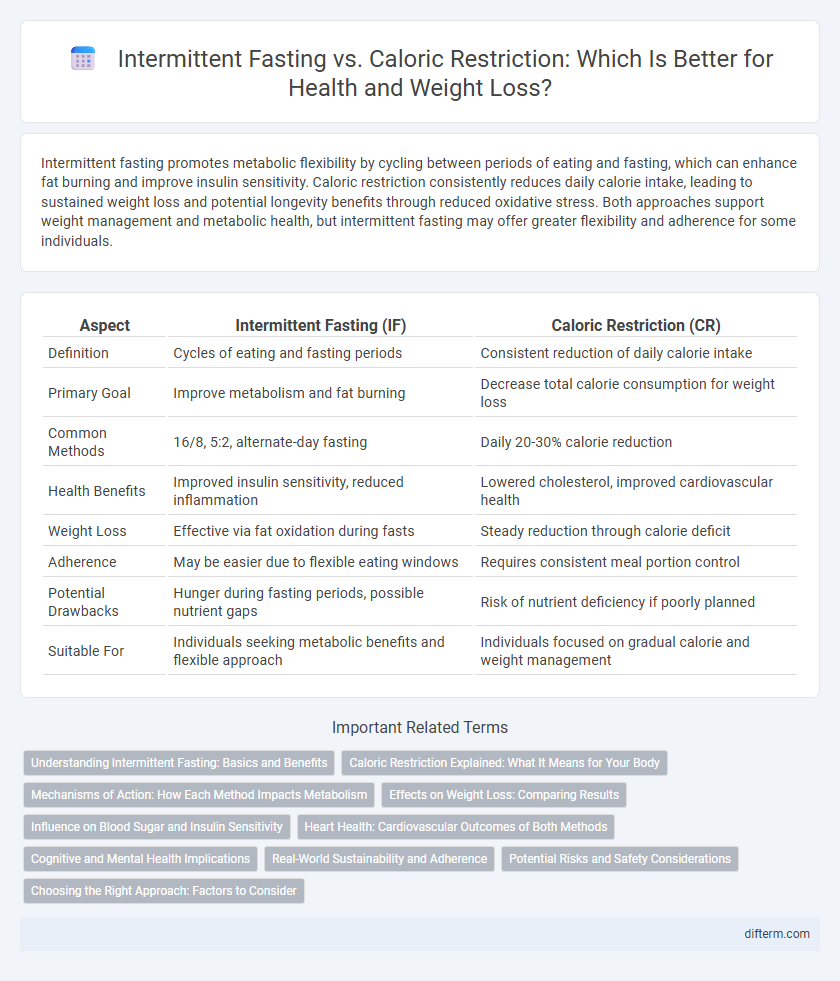Intermittent fasting promotes metabolic flexibility by cycling between periods of eating and fasting, which can enhance fat burning and improve insulin sensitivity. Caloric restriction consistently reduces daily calorie intake, leading to sustained weight loss and potential longevity benefits through reduced oxidative stress. Both approaches support weight management and metabolic health, but intermittent fasting may offer greater flexibility and adherence for some individuals.
Table of Comparison
| Aspect | Intermittent Fasting (IF) | Caloric Restriction (CR) |
|---|---|---|
| Definition | Cycles of eating and fasting periods | Consistent reduction of daily calorie intake |
| Primary Goal | Improve metabolism and fat burning | Decrease total calorie consumption for weight loss |
| Common Methods | 16/8, 5:2, alternate-day fasting | Daily 20-30% calorie reduction |
| Health Benefits | Improved insulin sensitivity, reduced inflammation | Lowered cholesterol, improved cardiovascular health |
| Weight Loss | Effective via fat oxidation during fasts | Steady reduction through calorie deficit |
| Adherence | May be easier due to flexible eating windows | Requires consistent meal portion control |
| Potential Drawbacks | Hunger during fasting periods, possible nutrient gaps | Risk of nutrient deficiency if poorly planned |
| Suitable For | Individuals seeking metabolic benefits and flexible approach | Individuals focused on gradual calorie and weight management |
Understanding Intermittent Fasting: Basics and Benefits
Intermittent fasting involves cycling between periods of eating and fasting, typically ranging from 16 to 24 hours, which promotes cellular repair and metabolic health. Research shows that it can enhance insulin sensitivity, support weight loss, and reduce inflammation more effectively than traditional caloric restriction. Key benefits include improved hormonal balance, increased fat oxidation, and potential longevity effects linked to reduced oxidative stress and enhanced autophagy.
Caloric Restriction Explained: What It Means for Your Body
Caloric restriction involves consistently reducing daily calorie intake without malnutrition to promote longevity and improve metabolic health. This dietary approach triggers cellular responses like enhanced autophagy, reduced oxidative stress, and improved insulin sensitivity, which collectively support weight loss and reduce the risk of chronic diseases such as diabetes and cardiovascular conditions. Research indicates that caloric restriction can modulate energy expenditure and hormone regulation, leading to sustained improvements in overall body composition and metabolic function.
Mechanisms of Action: How Each Method Impacts Metabolism
Intermittent fasting triggers metabolic switching by depleting glycogen stores and promoting fat oxidation, enhancing insulin sensitivity and cellular repair through autophagy. Caloric restriction consistently reduces overall energy intake, leading to decreased metabolic rate and improved mitochondrial efficiency, which lowers oxidative stress and inflammation. Both methods influence metabolic pathways but differ in timing and energy availability, impacting hormonal responses and gene expression related to longevity and metabolic health.
Effects on Weight Loss: Comparing Results
Intermittent fasting and caloric restriction both effectively promote weight loss by reducing overall calorie intake, but intermittent fasting may enhance fat loss while preserving lean muscle mass better. Studies indicate intermittent fasting improves metabolic health markers such as insulin sensitivity and lipid profiles more significantly compared to continuous calorie restriction. The timing of eating in intermittent fasting also supports improved energy regulation, contributing to sustainable weight loss results.
Influence on Blood Sugar and Insulin Sensitivity
Intermittent fasting and caloric restriction both improve blood sugar regulation and insulin sensitivity by reducing fasting glucose levels and enhancing cellular insulin response. Intermittent fasting typically triggers metabolic switching from glucose to fat-derived ketones, which can lead to more pronounced improvements in insulin sensitivity compared to continuous caloric restriction. Studies show intermittent fasting may lower fasting insulin and HbA1c levels more effectively, supporting better glycemic control in individuals with insulin resistance or type 2 diabetes.
Heart Health: Cardiovascular Outcomes of Both Methods
Intermittent fasting and caloric restriction have both shown significant benefits for heart health by reducing risk factors such as blood pressure, LDL cholesterol, and inflammation markers. Studies indicate intermittent fasting may improve insulin sensitivity and promote better lipid profiles, contributing to enhanced cardiovascular outcomes. Caloric restriction consistently lowers body weight and oxidative stress, key elements in preventing atherosclerosis and improving overall heart function.
Cognitive and Mental Health Implications
Intermittent fasting has been shown to enhance brain function by promoting neuroplasticity and reducing inflammation, which may improve memory and cognitive clarity compared to traditional caloric restriction. Caloric restriction, while effective for weight management, may sometimes lead to deficits in mood and energy levels, potentially impacting mental health negatively. Emerging research suggests intermittent fasting could offer superior cognitive benefits by stabilizing insulin sensitivity and boosting brain-derived neurotrophic factor (BDNF) more effectively than caloric restriction.
Real-World Sustainability and Adherence
Intermittent fasting often shows higher real-world sustainability due to its flexible eating windows, making it easier for individuals to adhere to without constant calorie tracking. Caloric restriction demands continuous monitoring of food intake, which can lead to lower long-term adherence and increased risk of burnout. Studies indicate that intermittent fasting fosters better behavioral adherence and sustained weight management compared to traditional caloric restriction methods.
Potential Risks and Safety Considerations
Intermittent fasting may increase risks of hypoglycemia, nutrient deficiencies, and eating disorders if not properly managed, especially in individuals with diabetes or pregnant women. Caloric restriction poses potential threats including muscle loss, reduced metabolic rate, and nutrient imbalances when prolonged or too severe. Both dietary approaches require medical supervision to ensure safety and address individual health conditions effectively.
Choosing the Right Approach: Factors to Consider
Choosing between intermittent fasting and caloric restriction depends on individual lifestyle, metabolic health, and long-term sustainability. Intermittent fasting may benefit those seeking simplicity and improved insulin sensitivity, while caloric restriction suits individuals preferring steady, measurable calorie reduction. Factors such as age, activity level, and medical conditions must guide personalized dietary strategies for optimal health outcomes.
Intermittent Fasting vs Caloric Restriction Infographic

 difterm.com
difterm.com